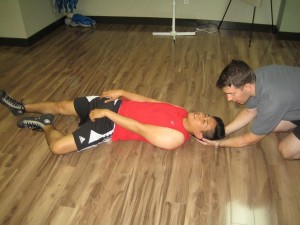
When one comes upon a patients one needs to know how to deal with that person based on procedure. In First Aid there is a systematic assessment that follows a particular order designed to assess the most important areas first. Below is the step by step assessment procedure for any trauma patient. ALWAYS go in the order below as sometimes the patient might be complaining about his leg and we focus on that not realizing that he has internal bleeding.
1. Outline of Initial approach to patient assessment
- Divided into primary and secondary surveys.
- Whenever possible, problems should be managed as soon as they are found before moving on with assessment.
2. Primary Assessment:
- This is the most important part of assessment.
- It is designed to quickly detect problems that are life threatening or may cause significant harm or damage. (loss of a limb or paralysis)
- Examples of problems
i. Airway obstruction or impending obstruction
ii. No breathing or inadequate breathing
iii. No circulation or inadequate circulation
iv. Bleeding
v. Decreased conscious level
- Problems in primary survey must be dealt with immediately and may warrant immediate transportation.
- Management/Arrangements for transportation must take priority, do not continue to secondary survey until this is done.
-
- Remembering your
- A
- B
- C’s
- Helps
- Responsiveness
- Airway
- Breathing
- Circulation
- Haemorrhage
- Responsiveness
i. Is the patient awake and completely oriented?
ii. Is the patient awake and confused
iii. Is the patient drowsy but can be aroused?
iv. Are you able to arouse the patient?
- Airway
i. Always considered C-spine if possible trauma
ii. The airway Maybe open
iii. Is there stridor?
iv. Other signs of respiratory distress
Tachypnoea
Rapid breathing
Hypopnoea
Shallow breathing
- Use of accessory muscles
- Posture
- Cyanosis
- Breathing
i. Is there breathing present?
ii. Look, listen, feel
iii. Is it adequate?
iv. Are there signs of respiratory distress?
- Circulation
i. Is it present?
ii. Is it adequate?
- Haemorrhage
i. External obvious
ii. Internal
- Suspect based on trauma, MOI, examination
- Locations: abdomen, chest, thigh
- Swelling, severe pain
- Penetrating injury
- Treat for shock
iii. Once life threatening problem identified or suspected
- Management started
- Arrangements for transport made
- Do vital signs at end of primary survey
3. Secondary survey
- Designed to be thorough
- Hopefully detect all problem, injuries or potential injuries
- Most important in trauma
- Patient may be unconscious
- Be thorough and systematic
- Head to toe
- For awake patient
- Be thorough
- Be guided by patient
i. Where does it hurt?
ii. Does this look different?
iii. Does this feel different?
- Compare sides right and left for differences.
|
|